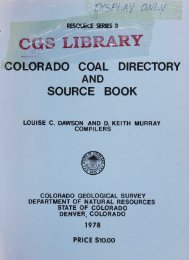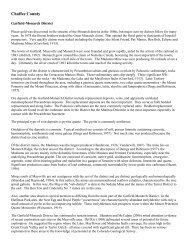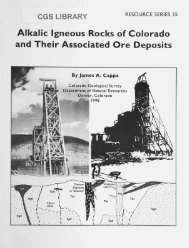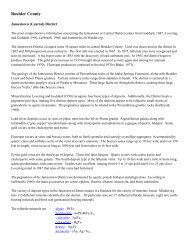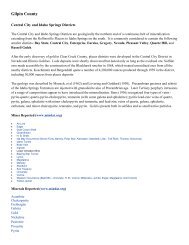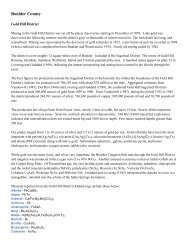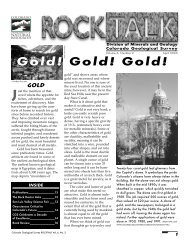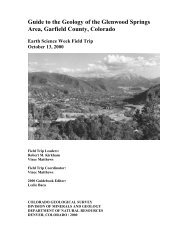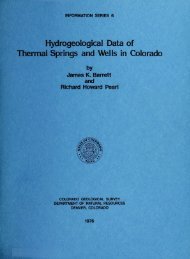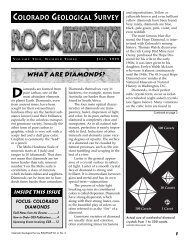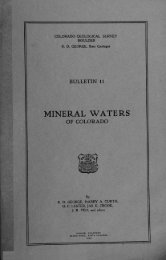Marble - Colorado Geological Survey
Marble - Colorado Geological Survey
Marble - Colorado Geological Survey
Create successful ePaper yourself
Turn your PDF publications into a flip-book with our unique Google optimized e-Paper software.
quarries, may be nothing more than planes of<br />
weakness or may be well developed, open<br />
cracks. Joint spacing is variable, ranging from<br />
tens of feet down to inches. Uniform, wide spacing<br />
of parallel joints can add to the value of a<br />
deposit as production costs will be decreased as<br />
waste may be minimized by running cut walls<br />
parallel with the major joint system.<br />
Joints were mapped within the project area<br />
to obtain the prevalent direction and orientation<br />
for quarry planning. Most of the major joints<br />
were oriented vertically in the old quarry area<br />
and have an easterly strike. The verticality is<br />
an advantage but the easterly strike requires<br />
that the blocks will be oriented at an angle to<br />
the strike of the outcrop and hillside. Joints to<br />
the south in the outcrops of white marble are<br />
random and more prevalent. Experts in the<br />
field and CGS's examination of the Yule Quarry<br />
indicate that jointing decreases with distance<br />
from surface weathering. However, there are<br />
beds of marble that are so severely jointed that<br />
no blocks could be successfully quarried.<br />
Specifically, these areas include the white beds<br />
above the previously quarried marble, and the<br />
upper beds along the south property line.<br />
Soundness is also a function of mineral constituents<br />
and texture when considering the<br />
competence of marble when slabbed. Variable<br />
cohesion between non-uniform size and type of<br />
mineral grains can place restrictions on product<br />
use or may require slabs to be reinforced.<br />
Open voids, veins, or flow structures can also<br />
decrease the competence of marble when slabbed.<br />
Based on knowledge gained through years<br />
of practical experience, marble has been universally<br />
classified into four groups based on<br />
characteristics encountered upon fabrication.<br />
The system indicates required fabrication techniques<br />
which are considered necessary, as based<br />
on standard trade practice (MIA, 1987):<br />
Group A: Sound marbles and stones, with<br />
uniform and favorable working qualities.<br />
Group B: <strong>Marble</strong>s and stones similar in<br />
character to the preceding group, but with<br />
working qualities somewhat less favorable; may<br />
have natural faults; a limited amount of waxing<br />
and sticking necessary.<br />
Group C: <strong>Marble</strong>s and stones with some<br />
variation in working qualities; geologic flaws,<br />
voids, veins, and lines of separation are common;<br />
it is standard practice to repair these variations<br />
by sticking, waxing, and filling; liners<br />
and other forms of reinforcement employed<br />
when necessary.<br />
Group Ds <strong>Marble</strong>s and stones similar to the<br />
preceding group, but containing a larger portion<br />
of natural faults, and a maximum variaion in<br />
working qualities; requires more of the afore<br />
mentioned finishing techniques. This group comprises<br />
many of highly colored marbles prized<br />
for their decorative qualities.(After MIA, 1985)<br />
<strong>Colorado</strong>-Highland marbles generally fall<br />
into Group B. Polished slabs are fairly competent<br />
except for a few scattered grains which may<br />
spall out during finishing. All material collected<br />
and finished is from the weathered zone of<br />
the deposit. Soundness and polishability are<br />
expected to increase with depth.<br />
All of the above mentioned characteristics of<br />
a building stone can affect market value. It is<br />
the aesthetic qualities of polishability and general<br />
attractiveness though which will ultimately<br />
place a particular stone in high demand.<br />
Engineering Constraints of <strong>Marble</strong><br />
Modern building design and construction requires<br />
increased knowledge of the physical<br />
limitations of building materials. As performance<br />
requirements become more demanding, so<br />
does increased need for quantitative data on<br />
construction materials. The Natural Building<br />
Stone Committee of the American Society for<br />
Testing and Materials (ASTM) has established<br />
standards for the testing and documentation of<br />
the physical properties of marble. The recommended<br />
tests are:<br />
C97 Absorption and Specific gravity<br />
C99 Modulus of Rupture<br />
C170 Compressive Strength<br />
C241 Abrasion Resistance<br />
C880 Flexural Strength<br />
Standard specifications for marble building<br />
stone (exterior), and descriptions of test methods<br />
from the Annual Book of ASTM Standards<br />
are referenced at the end of this report. It<br />
29



